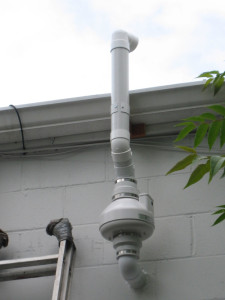Challenge
Mundell & Associates, Inc. (Mundell) was hired to review reports documenting VOC groundwater impacts migrating from an industrial facility on to our client’s residential and commercial property in Indianapolis. Several phases of investigation prompted the collection of various data sets of soil gas, sub-slab and indoor air VOC results showing vapor intrusion was a concern on the property. Complicating the situation was the discovery of an historic dry cleaner location situated among other commercial units/tenants further downgradient from the apartments in a plaza complex. Our client, the current owner, was focused on having the risks assessed at the site while at the same time working together with the Indiana Department of Environmental Management’s (IDEM’s) project managers for an effective overall solution progressed.
Action
Based on data collected, risk calculations and guidance given in several regulatory documents, Mundell installed four indoor air mitigation systems in September 2006 in the commercial units. The goal of this “radon” type system was to apply a vacuum on the sub-floor slab air environment and discharge the collected air to safe outside locations, thus alleviating the indoor air quality concerns from subsurface VOC impacts at the property. Additional indoor air mitigation systems were installed in April 2008 in several apartment complex units still being potentially affected by the upgradient VOC plume. Mundell developed a system of monitoring the air mitigation systems effectiveness using field measurements, laboratory analysis, and mass of contaminants removed calculations.
Results
A follow-up indoor air sampling event was conducted by Mundell in October 2006 in the commercial units to evaluate post-installation mitigation system effectiveness. Data showed the systems had reduced the indoor air concentrations by approximately 95 % of their pre-mitigation concentrations.
Subsequent testing shows indoor air concentrations now meet IDEM April 2006 levels. Contaminant calculations continue to show a reduction in indoor air concentrations and the steady cumulative increase in contaminants removed, measured in the system discharge stacks.





